Section 1:
Market Overview
Key Points
- Dramatic changes in technology have accelerated previous notions of connected devices. Current estimates project that by 2020, 50.1 billion ‘things’ will be connected and/or have some level of intelligence. This modern Internet of Things (IoT) is expected to have massive economic impact, with the McKinsey Global Institute anticipating $11 trillion in global economic value-add by 2025.
- The Internet of Things ecosystem is made of four main parts. Hardware encompasses everything from the newly connected devices to the networks and servers needed to support operations. Software includes all applications that access or control these connected systems, and those applications can come from a variety of providers. Rules and standards will be needed in order to realize the true potential of the technology. Finally, services will be laid on top of this complex landscape to provide value for a broad range of companies.
- Awareness towards IoT has grown, with 68% of end-user companies saying that they are aware of this trend. Along with that awareness, sentiment towards the trend is getting warmer, especially in the IT channel, where 36% of companies expect that solution providers will profit from IoT.
Market Overview
Everything that can be connected, will be connected. This assertion aptly captures the essence of what is known as the Internet of Things (IoT). There is a steady march to enhance the utility of devices, objects, structures and even people through connectivity, network effects and intelligent functionality. Over the past two years, this concept has evolved from a technologist’s curiosity into a full-fledged business opportunity.
While there have always been ‘things’ connected to the Internet – think computing devices, as well as things connected to other things, such as ATMs, RFID tags or E-ZPass—something has clearly changed. Advancements in a number of areas over the past decade have laid the groundwork for the steepening IoT growth curve.
The dramatic rise in computing power and storage capacity offered at ever-lower prices, coupled with the miniaturization of sensors and chips, robust wireless networks, IPv6, and a software-defined world, to name a few enabling factors, make this iteration of the Internet of Things different than prior eras.
The first use of the term Internet of Things is widely attributed to Kevin Ashton, executive director of the Auto-ID Center at MIT, who used it in a 1999 presentation he made to Procter & Gamble. Nearly twenty years later, definitions and interpretations still vary widely. One simple and concise way to think about the Internet of Things comes from the Oxford online dictionary:
Internet of Things: a proposed development of the Internet in which everyday objects have network connectivity, allowing them to send, receive and act on data.
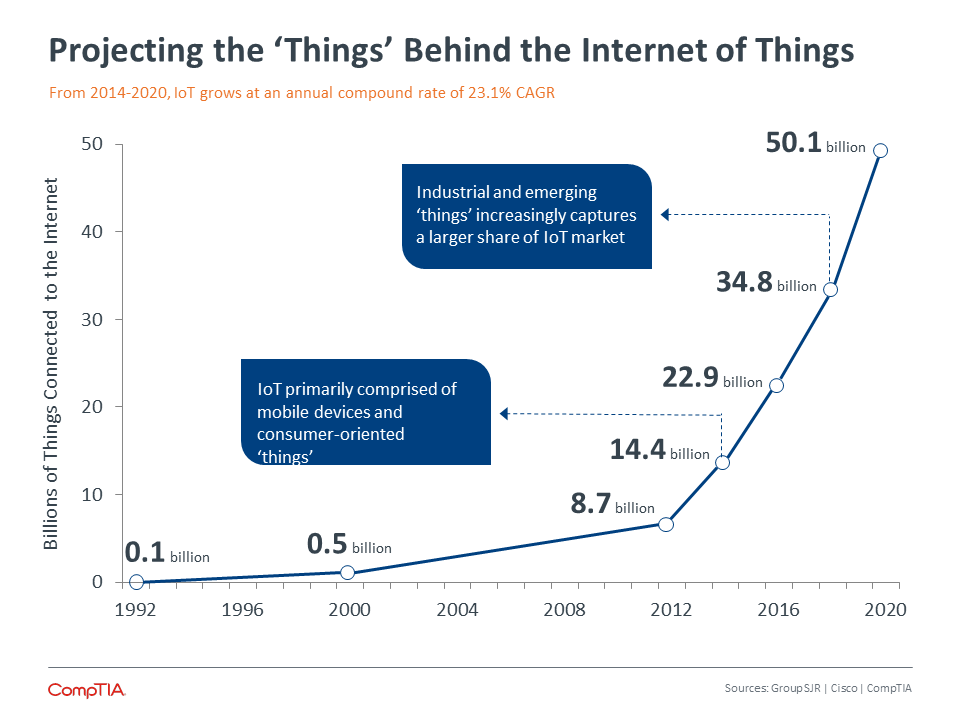
The key part of this definition is “everyday objects.” While adding connectivity and intelligence to electronic devices is a first step into this world, the real explosion of potential applications and new opportunities comes as commonplace physical items are digitized and connected into an intelligent network.
Estimates put the number of ‘things’ connected to the Internet at 50.1 billion by 2020. This translates to approximately 6.3 connected things per person if distributed evenly across the planet. It doesn’t take much, however, to envision scenarios where the per person count is much greater. A connected computer, mobile phone, tablet, printer, TV, media streaming device, watch, fitness monitor, household monitors (security, fire, HVAC, flooding, etc.), car, appliances, and lighting may at some point become common. When adding in businesses or cities and all of the potential areas of connectivity, IoT projections seem quite reasonable.
The count of ‘things’ provides a sense of scope and scale, but that is only half of the story. The revenue side of the equation suggests an equally impressive outlook.
With IoT extending digitization into the physical world, it is no surprise to see massive numbers when it comes to broad economic impact. A report published by the McKinsey Global Institute projects that IoT will result in upwards of $11 trillion in global economic value-add by 2025 – the combined benefits that businesses will derive through the sale and usage of IoT technology. Similarly, General Electric predicts the Industrial Internet, their interpretation of IoT, to boost global GDP by $15 trillion over the next 20 years. Keep in mind, quantifying value-add benefits, such as time savings or productivity gains is always difficult, with small changes to assumptions often having large impacts.
IDC narrows in on the IoT market itself, projecting the worldwide market for overall IoT solutions to grow from $1.9 trillion in 2013 to $7.1 trillion in 2020. To put that into context, the global IT industry, including telecom, is estimated to reach approximately $3.8 trillion in 2016. IDC has recently refined their estimate to exclude “intelligent systems”—high-level systems that include IoT components. The 2020 revenue estimate for the remaining core IoT market is $1.7 trillion. The difference between these two projections further confirms the breadth of ‘things’ that will be part of the Internet of Things. The IT industry undoubtedly sits at the heart of developing, supporting and maintaining IoT, but revenue and value is expected to flow across every sector in the economy.
As this report will show, the IoT ecosystem is complex, and each component will drive significant activity. Research firm MarketsandMarkets breaks down several of these individual areas:
- IoT security—addressing concerns around critical infrastructure and privacy—is estimated to be worth $36.95 billion by 2021.
- A main driver behind IoT is the desire to gather more data and make better decisions. The IoT analytics market is estimated to be worth $16.35 billion by 2020.
- Driven by embedded processors, sensors, and antennas, the IoT chip market is estimated to be worth $10.78 billion by 2022.
Additionally, MarketsandMarkets provides information on how this trend will affect different verticals:
- As the healthcare market continues to aggressively pursue technology to improve patient care, the IoT healthcare opportunity is estimated to be $163.24 billion by 2020.
- Likewise, retailers are using technology to find new customers and improve the experience. The IoT opportunity in the retail space is estimated at $35.64 billion by 2020.
If everything falls into place, these lofty projections may very well come to fruition. But, what will it take for everything to fall into place? There is a complex ecosystem surrounding the development of IoT technology, and understanding this ecosystem is the first step towards addressing security pitfalls, privacy concerns, or monetization challenges.
The Internet of Things Ecosystem
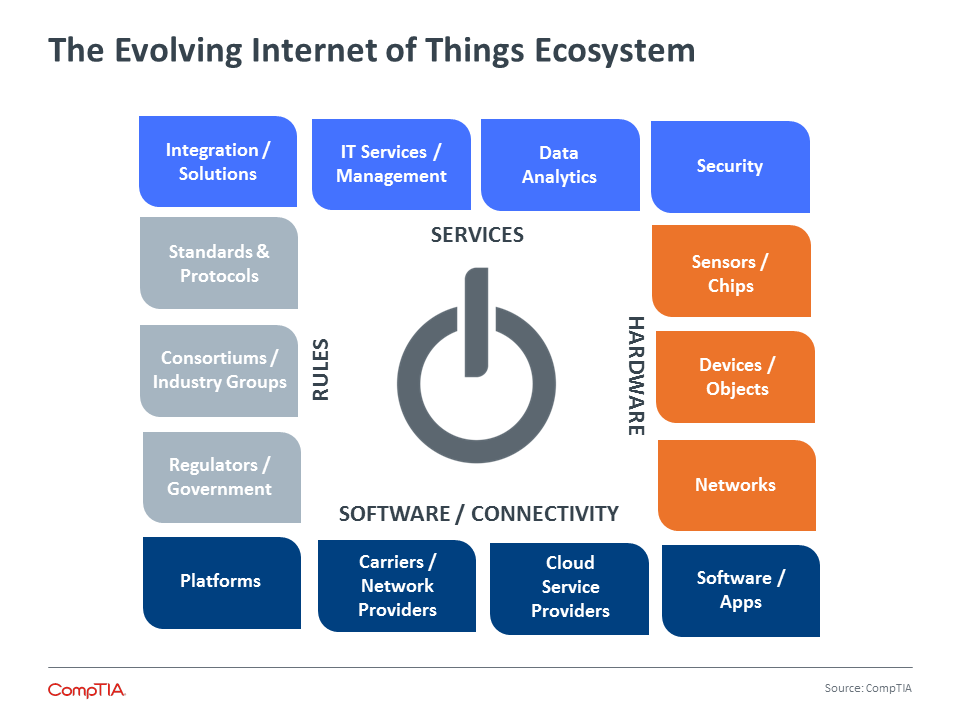
As with most recent trends in technology, the Internet of Things is composed of many different pieces working in concert to create a new model. IoT is a perfect example of the developments referenced in a recent McKinsey and Company paper on digital transformation: “The digital technologies underlying these competitive thrusts may not be new, but they are being used to new effect.”
Although ‘Internet of Things’ may not be the catchiest name the industry could have chosen for this trend, it actually is a fairly good reflection of the composition of the underlying ecosystem. Just as the traditional Internet has many different components and is not a discrete product, IoT has many pieces that must be understood at a basic level in order to build value-added services.
Hardware
Hardware, including the ‘things’ in IoT, is the first piece of the puzzle. Advances in miniaturization and the low cost of high performance silicon (as dictated by Moore’s law) have led to both sensors and compute components that can affordably be placed in practically any type of device. Inexpensive sensors can measure everything from geolocation to temperature to blood pressure and translate this information into a digital format. Computing can be done onboard in many cases, or the data can be transmitted to a central compute location.
The type of device that might contain this capability is practically limitless. At one end of the spectrum are extremely large devices such as cars, which are soon expected to carry over 200 sensors each. At the other end are devices such as the Michigan Micro Mote, which packs processing, data storage, and wireless communications into less than a cubic millimeter. In between are any number of objects that have never before had compute capability or connectivity, and the vast majority of these will come from vendors that have not traditionally been part of a technology solution.
A final piece of hardware to consider is the network. With so much data being transmitted, robust networks will be a critical part of any strategy around IoT; in fact, much of the momentum behind the trend has been generated by producers of networking equipment. The need is very real, though—CompTIA research consistently shows that unplanned network upgrades often contribute to the hidden costs behind new technology implementations.
Software/Connectivity
On its own, a collection of chips and sensors has limited use. Software is required to tie everything together or make the data usable, and connectivity is required to share information or communicate with the entire system.
The software component begins with new platforms. The primary example of this is the new operating systems that have dominated the mobile device landscape. During the PC/Internet 1.0 era, Microsoft Windows was the dominant OS, especially in terms of front-end or consumer computing. With smartphones and tablets, iOS and Android have become major players. As consumers expand their notion of computing to include wearables, homes, and cars, different vendors are also seeking to expand their operating systems into those areas.
Aside from the operating systems, there is a firmware of sorts needed for IoT to be successful. This firmware itself is made of multiple components. As the cloud is a primary tool in facilitating IoT, the software by cloud providers to construct their offering plays an important role in the overall solution. This software is made available to other parties through APIs, which will be dependent on both the cloud software and the access a cloud provider is willing to grant.
Many companies that have traditionally operated as telecom carriers are looking into providing cloud solutions as well, and these offerings could be of interest if they are packaged with broad network capabilities. Cellular and Wi-Fi networks have enabled modern computing models, but they also come at a cost that must be considered when building a plan around new data streams.
Rules
Hardware, software, and connectivity make up the technical foundation for IoT, but there is another major element that will dictate the way the subject develops. Standards, regulations, and best practices will shape the way that companies implement projects, and several different organizations are involved in helping build these rules for IoT.
Choosing Sides
Many organizations have formed in an attempt to define standards for IoT. Standards are needed in each area of the IoT stack—applications, services, network, and access. Some companies are throwing their full support behind a single endeavor, while others are participating in multiple groups in order to be well positioned as the landscape shifts. These are some of the primary groups in this space today:
AllSeen Alliance: One of the first groups to form, AllSeen has used Qualcomm’s AllJoyn device interconnect framework as a foundation. Other members include IBM, Cisco, Microsoft, and LG.
Open Interconnect Consortium: Driven by concerns over Qualcomm’s interests in promoting AllJoyn, the OIC is seeking a more ground-up protocol creation. Members include IBM, Intel, Dell, and Samsung.
Thread: Thread is another ground-up effort to create a networking protocol with better security and low-power features than Wi-Fi, NFC, Bluetooth, or Zigbee. Members include Nest (a division of Alphabet), Samsung, ARM, and Freescale.
Industrial Internet Consortium: The IIC is focused on bringing connectivity and intelligence to industrial applications. Members include GE, IBM, Intel, AT&T, and Cisco.
Wireless IoT Forum: This group has a particular focus on spectrum, with a goal to drive standards and counter fragmentation in licensed and unlicensed wireless M2M market. Members include Cisco, Arkessa, Telensa and WSN.
Many industry observers view standards as the largest hurdle to mass adoption. This, of course, is typical whenever a new technology format or model is introduced. Betamax/VHS and HD DVD/Blu-ray are popular examples of standards battles that eventually produced a clear market leader. The IoT standards discussion will most closely resemble the development of the TCP/IP model that enabled the traditional Internet to become ubiquitous. The discussion is less about a winning format and more about overall function and usability.
Just as TCP/IP encapsulates several networking layers (link, internet, transport, and application), a standards model for IoT will need to address several areas. IoT layers will include connectivity (where cellular networks and Wi-Fi networks must be combined in optimal ways), data transport (where TCP packets may need to be modified to account for network constraints), and devices (where power consumption concerns will drive practices). New protocols such as 6LoWPAN, Constrained Access Protocol (CAP), and Time Synchronized Mesh Protocol (TSMP) will be introduced throughout the ecosystem as the various layers need to interact with each other.
The technical side is just one half of the challenge in successfully building IoT systems. The other half is in dealing with social concerns, such as the security and privacy implications inherent in mass numbers of connected devices sharing data. Here, there will likely be government action, building on regulations that have been established to cover activities such as electronic health records or digital collection of financial information.
Services
Services are typically not considered to be part of an ecosystem; instead, they are built at a higher layer to combine foundational pieces into a cohesive offering or to simplify the solution for an end-user. This is partly the case with IoT, but there is also an argument that services are more tightly ingrained into the basic ecosystem.
While the IoT ecosystem consists of hardware, software, and rules, the true value lies in the data being generated, captured, and analyzed. This data does not hold much value on its own without services that perform the analysis and present findings or insights in a useable way. Additionally, the data has to be highly available and tightly protected.
The complexity of IoT is another factor that drives a critical need for services. Standards and protocols will help create some conformity, but the reality is that there will still be multiple systems interacting. Consider a smart home, where HVAC, lighting, and home entertainment (among others) will generate data that a homeowner will want centralized for control. That central control will likely need to be available on a variety of different platforms—PC, tablet, and smartphone. Even with standards in place, creating this comprehensive system is a complicated task.
Services, then, are an important ingredient in realizing the full benefits of IoT. Whether the service is at a higher level dealing with data and integration or at a lower level dealing with infrastructure, there are many opportunities for channel firms to build offerings around this new trend.
Ready for Prime Time
As the pieces start to come together, companies are showing a readiness to incorporate IoT into their technology and business strategies. The first step in adoption is awareness, and IoT is well-known: 68% of end-user companies say that they are aware of this trend. Of that group, many have moved past awareness and started an IoT initiative.
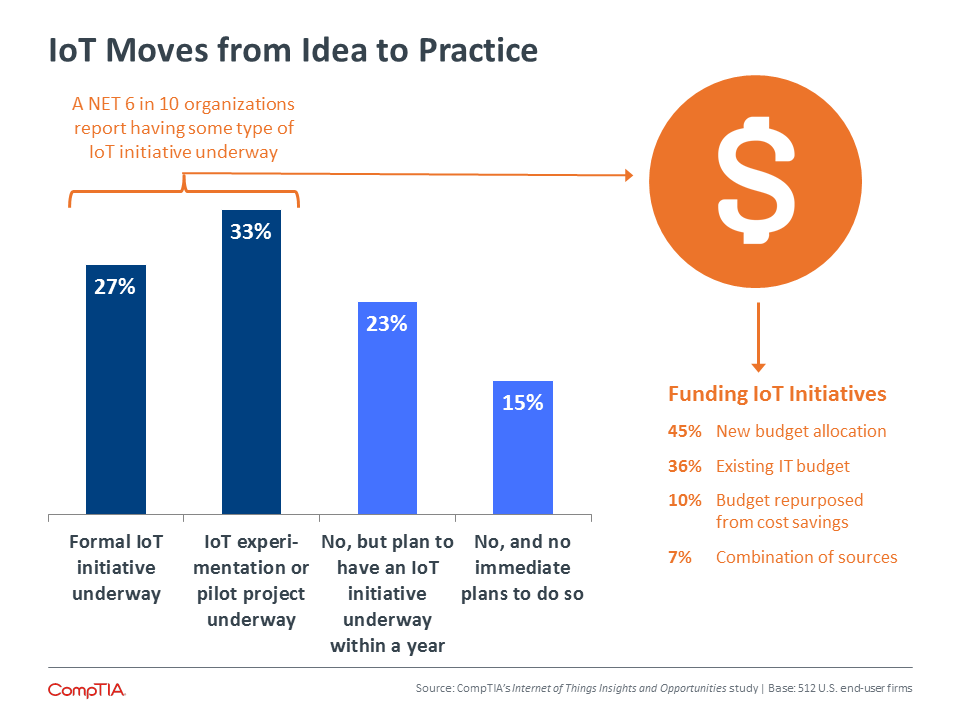
The channel sees similar activity among its client base. Channel firms say that 10% of their clients are heavily integrating IoT components, and 23% are pursuing initial implementation of IoT components. Forty-four percent are simply in an early exploration and education stage, and 22% show no interest at all. The difference between end-user adoption and channel client adoption is due to company size—end-user adoption is skewed towards large and medium-sized businesses that tend to have their own internal technical team and may not rely as much on third parties.
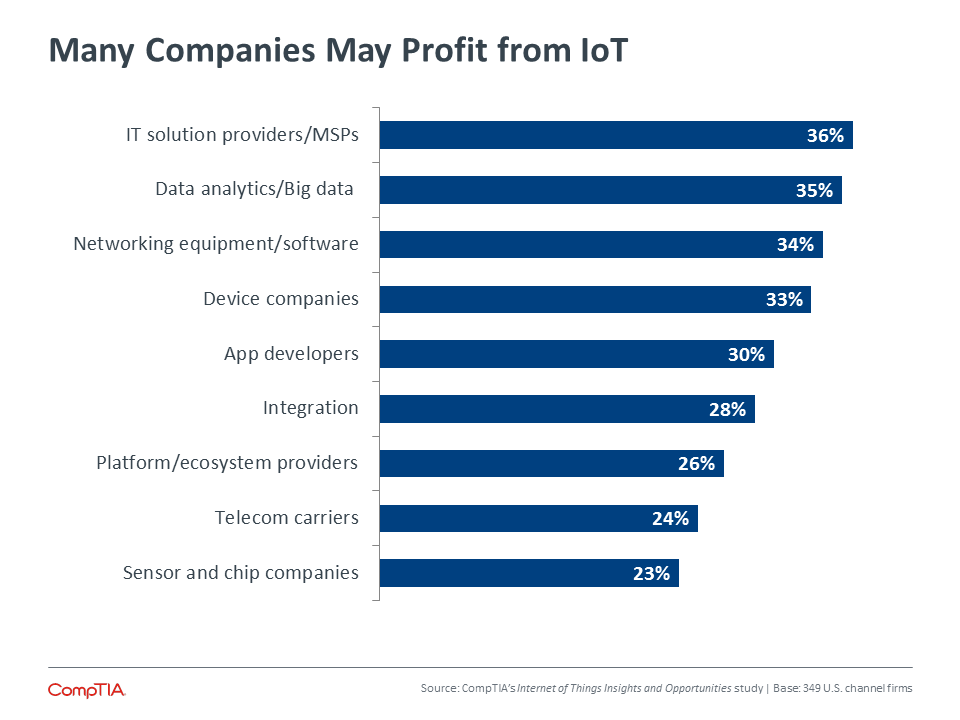
As IoT initiatives get started, companies are exploring products and services from a number of different vendors. New hardware companies provide modern connected devices, new software companies deliver applications for controlling and monitoring, and new service companies tie everything together and analyze the data. In contrast to last year, channel companies have moved away from believing that the companies providing components (hardware, apps) will be the most likely to make money. Instead, they view themselves as strong profitability candidates.
This makes sense for two reasons. First, the complexity of IoT projects is beyond what many companies can handle internally. Especially on the SMB end of the spectrum, end-users will be looking for end results without necessarily building out the entire solution on their own. Second, many areas of IoT can be seen as extensions to skills or lines of business that solution providers already have.
- Devices: Most break/fix or device management efforts today are focused on office equipment such as PCs or printers, but the same skills and considerations can apply to new devices and sensors. There will be some new areas to consider, such as power usage, security, and network protocols. However, the general business processes for device repair and upkeep will be applicable, as will any experience in monitoring connected devices.
- Data Analytics: While the data streams generated by IoT devices will require new data warehousing techniques and new analytics tools, these new functions are often complementary to existing techniques and require a strong foundation in data management. CompTIA research has found that many companies, especially in the SMB space, do not have this foundation. These companies can benefit from data audits along with more traditional tools such as SQL or relational databases before moving into new areas.
- Integration: As with data analytics, many channel firms are already providing integration services. These firms recognize that integration typically constitutes the bulk of the effort for a new IT product and have built the planning practices necessary for integrating complex systems. The new skills required for IoT integration will be the APIs that connect various devices and services, especially as standards are in flux.
For channel firms to take full advantage of the IoT opportunity, they will need to continue transforming along the path forged by cloud and mobility. IoT solutions for the most part will be an ongoing process with recurring revenue, so the business model must account for these things. There will need to be incremental learning for the familiar technical areas and deeper learning or partnering for non-familiar technical areas.
Section 2 of this report looks more closely at the channel opportunities and challenges that exist when entering this new market. Section 3 examines the demand side of the equation, with an analysis of end- user attitudes and practices. The Internet of Things has moved past the initial hype phase, and now it’s time for businesses to figure out how to use this new technology to go to the next level.
Section 2:
Channel Dynamics
Key Points
- Rising sentiment around the Internet of Things (IoT) has led to rising interest within the channel. Channel firms are seeking out information on the topic from various sources, and the revenue expectations for this field also reflect a growing optimism. A number of opportunities exist for the channel across the four components of the IoT ecosystem.
- In starting discussions with their clients, channel firms recognize that IoT solutions often are not standalone initiatives. To incorporate IoT into strategic objectives, solution providers will have to focus on realizing the benefits they expect to see, such as improved customer experience (reported by 41% of companies), better asset visibility/monitoring (40%), and cost savings/higher efficiency (39%).
- Forty-nine percent of channel firms feel that security will be a major focus as companies move forward with IoT adoption. Newer topics such as vulnerabilities left open by device manufacturers and the collection of personal data come alongside ongoing concerns such as hacking or malware as companies determine the proper approach for IoT security.
Warming Up to IoT
The channel never quite had the same type of uncertainty towards Internet of Things as it did towards cloud computing. Cloud created doubts around viable business models for the future, driven in large part by the fact that cloud rapidly proved itself as a trend with staying power. IoT has not moved as quickly through the hype cycle. Whether because of the name or the consumer-centric examples (zombie refrigerators?), many firms have legitimately wondered if IoT was just a passing fad.

In the past year, sentiment around IoT has swung to the positive side. Thirty-nine percent of channel firms have a significantly more positive view of IoT than they did a year ago, and 36% have a slightly more positive view. Another 21% have not changed their opinion over the past 12 months, and this certainly includes firms that were bullish on IoT to begin with. Compared to other emerging technology, such as VR or AI, IoT definitely shows significant traction. See CompTIA’s research brief Tech on the Horizon: From VR to Bots for more information on how these trends are viewed by channel firms.
Rising sentiment has led to rising interest, and channel firms are clearly seeking out more detailed information compared to the way they gathered data a year ago. Last year, one of the fastest-growing sources of information was IoT vendors. This year, that momentum has moved further down the chain, as solution providers are actively having discussions about implementing IoT and doing their own digging to find the best offerings.
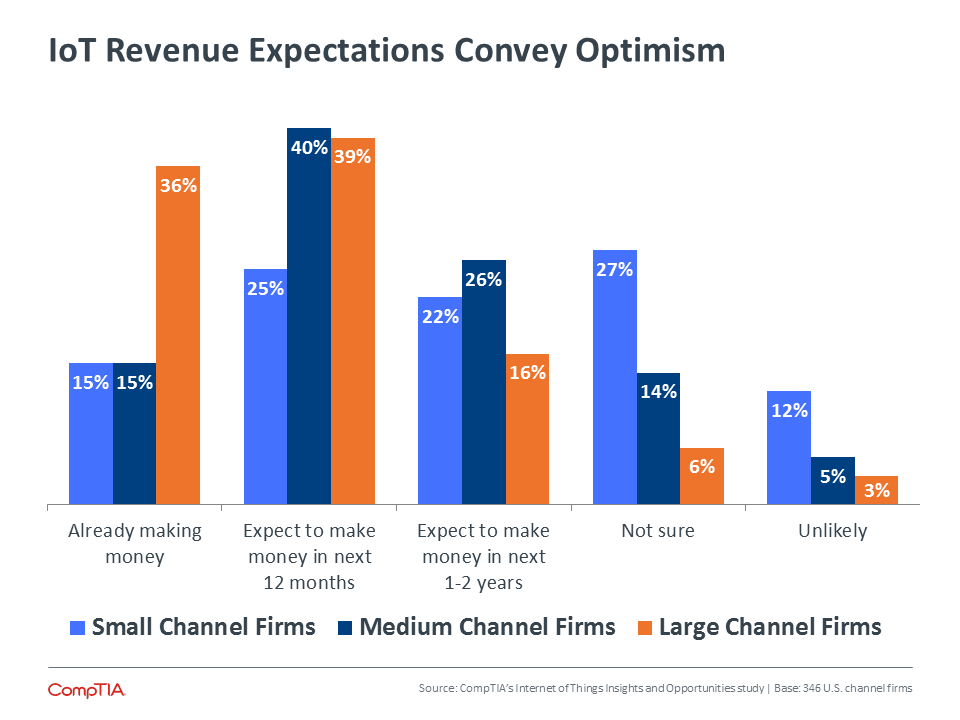
Active discussions with current customers or future prospects indicates that channel firms are well on their way to answering the key question of any new trend: how do we make money? The experience with cloud computing has probably helped here. Channel uncertainty around cloud computing centered around the fact that cloud represented a new way of doing IT. Managed service providers accustomed to ongoing client operations had familiarity with the new model, but companies focused on product sales or one-time transactions had a steeper learning curve. IoT likewise is typically not represented by a single product or project, but signals a new operational model. The fascinating thing about IoT is that the model applies not only to IT, but to several other aspects of a business.
The channel is making significant progress with monetizing the IoT opportunity. Last year, only 8% of channel firms surveyed said they had already made money from IoT offerings; this year, that number is up to 23%. Large firms (50+ employees) are making the most headway—36% of large businesses are already making money compared to 15% of medium-sized firms (20-49 employees) and 15% of small companies (less than 20 employees).
Looking forward, though, the picture balances out. One third of channel firms expect to make money from IoT in the next 12 months, including 39% of large companies, 40% of medium-sized companies, and 25% of small companies. In the following 12 months, another 21% expect to see some IoT revenue, with the balance shifted more towards the smaller end of the scale. Twenty-three percent of channel firms remain unsure of IoT’s financial impact or view it as an unlikely proposition, with small companies unsurprisingly dominating this segment.
As described in section 1, the IoT ecosystem is complex and comprises hardware, software, rules, and services. The types of offerings that channel firms may provide for clients span these four areas. For its survey, CompTIA selected a representative group of channel services to gain a basic understanding of the IoT landscape today. Obviously other services such as white-labeling, referrals, or help desk could be placed in the context of the ecosystem.

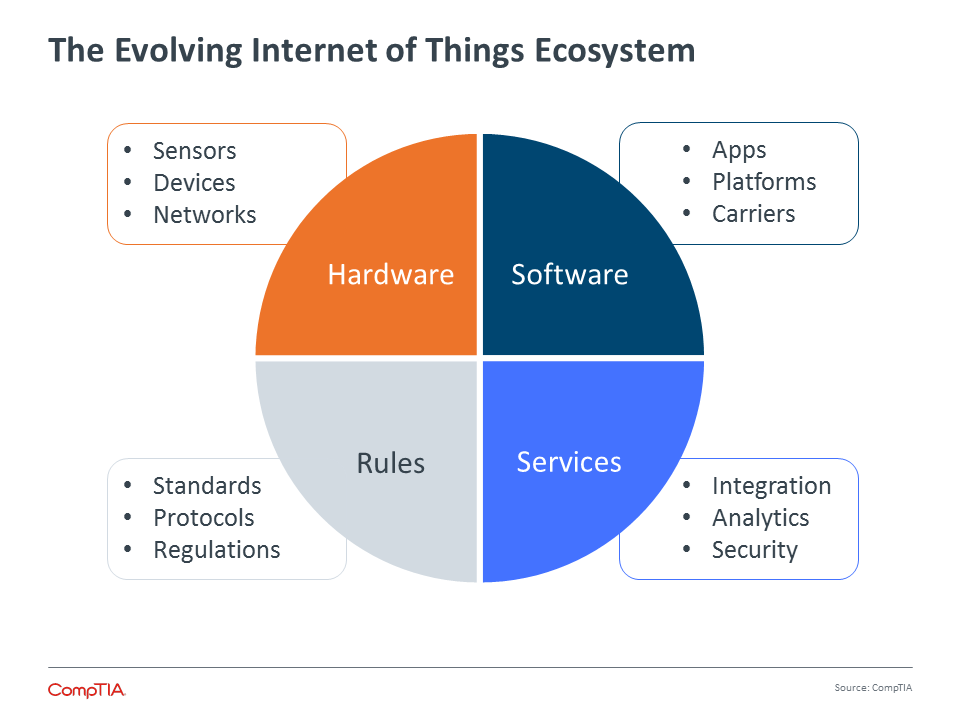
Consulting is the most popular IoT channel offering at this point, with 40% of the firms surveyed offering something in this space. This makes sense since IoT is in its early stages and has broad applications. The next most popular offering is security, offered by 36% of firms surveyed. This fits with the overall industry trend of companies redefining their security approach in the face of new technology. Both the broad application possibilities of IoT and the security ramifications will be examined in more detail later in this section.
The next group of offerings are tightly clustered. Analytics, managed services, custom apps, reselling, and infrastructure services are all offered by 30%-35% of firms surveyed. Another offering in this group is full-solution implementations. Like consulting, this spans all areas of the ecosystem. Also like consulting, this is a broad category, and what constitutes a full implementation for one firm may differ from another firm’s definition.
Break/fix and integration are lower on the list. Given that the technology is new, it will take time for break/fix demand to build for IoT components. Integration’s position is interesting—it suggests that some end-user companies may not be tying their IoT implementations back into the legacy parts of their architecture during early exploration. This may be a way of testing out the space, but this integration will obviously need to happen for the full benefits to be realized.
The least common channel offering is specific applications related to IoT, such as smart cities. These specific applications tend to be those that businesses imagine as new initiatives that utilize previously unavailable capabilities. Again, early adoption will be marked more by using IoT to augment existing operations, but these novel applications will soon be a large part of the market.
The Customer Dialog
Today’s technology pitches and discussions look different from those in the past. Instead of focusing primarily on technical specifications that improve the underlying architecture supporting operations, there is more focus on the way that technology fits into overall organizational objectives. For IoT, several factors play into the customer conversations.
As discussed previously, IoT can apply very broadly, going beyond IT operations and reaching into other facets of the business. The ability to connect and give intelligence to physical devices can transform processes that were once low-tech, such as building maintenance or inventory monitoring. In fact, this is the predominant way that end-users view IoT today, according to the channel.
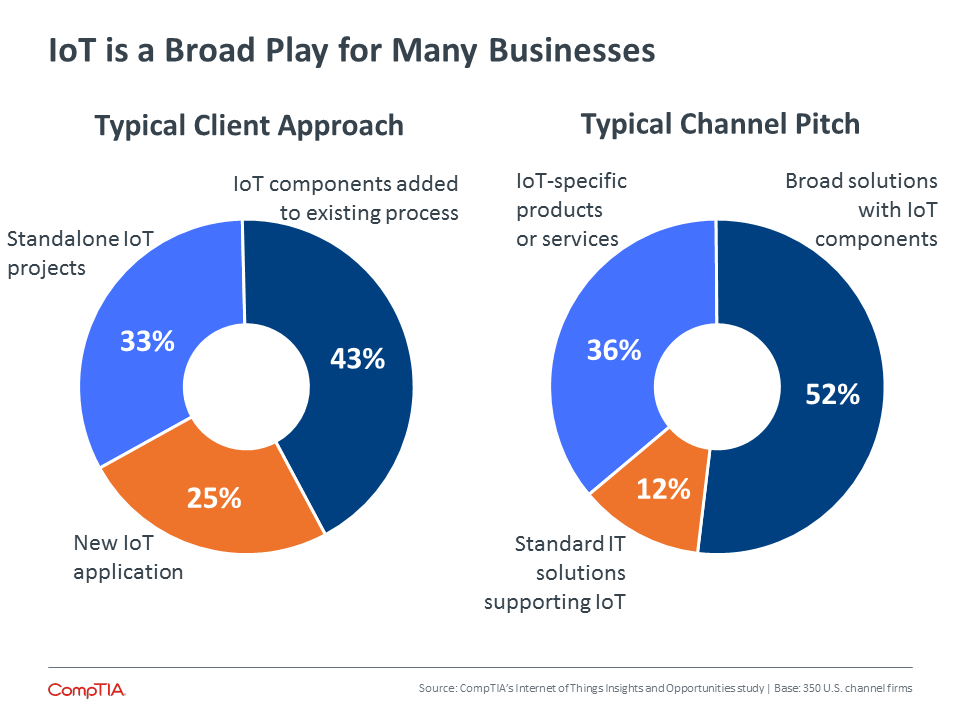
Channel firms have responded to this approach by predominantly offering broader solutions that incorporate IoT components. However, that is clearly not the only play. New IoT applications may heavily require IoT-specific products or services, and standard IT installations or upgrades (networking, storage, etc.) can help support IoT activity.
IoT can be woven into strategic goals in many ways. When asked to evaluate the most likely uses of IoT in the enterprise, channel firms saw many areas of potential. Creating new opportunities from connected systems (49%), controlling/monitoring equipment (48%), collecting new data (46%), and gathering contextual information about customers (43%) are all highly rated by channel firms as ways that IoT will deliver value. Slightly lower on the list is adding intelligence to objects that were previously “dumb” (39%). Early efforts involve extension while innovation comes with some maturity.
Regardless of the application, the key goal in an IoT discussion is to determine what the benefit is. The wide range of likely benefits the channel expects to see from IoT is another signal that the channel has warmed to the idea of IoT as a sustainable trend.

On one hand, tight groupings can indicate uncertainty. Channel firms may feel that several benefits are all theoretically possible, so they are betting that they will come to fruition. On the other hand, IoT is clearly a wide-ranging development. It is very likely that companies implementing IoT initiatives actually will realize many different benefits.
Of course, benefits do not come for free. Between the challenges that end-users foresee for their clients and the challenges they expect for themselves, there are many hurdles in the way of IoT’s progress. For end-users, security tops the list followed by interoperability—an interesting viewpoint given the low number of channel firms performing IoT integration. It is also interesting to note that the top challenge that channel firms deem very significant is not choosing a business model. This was the top challenge in the early days of cloud, and perhaps many firms have made their shift and feel well positioned. Instead, they realize that they now need to build their skills.

Having the right skills in place is the final part of the client discussion. Customer expectations have risen thanks to the availability of cloud services and the functionality of mobile devices, and high quality solutions require high quality skills, especially in a complex space like IoT. Less than a third of channel firms surveyed viewed themselves as experts in several trends used for building IoT solutions, including cloud computing, data analysis, storage, networking, and security (see Appendix). Correspondingly, those companies that have already made money from IoT report that those fundamental areas are the top ones that have seen skill growth, even more so than IoT-specific areas like new devices or machine-to-machine (M2M).
Although IoT has been the recent hot trend, it is important to remember how it is different from the trends of cloud and mobility—namely, it has been built on top of those two trends. This is one more proof point that cloud and mobility have defined a new era of enterprise computing. The concepts and tenets of that pair are being used to create new fields with massive potential, and having the right business model and skills for the new field requires a strong foundation in the basic ingredients.
Security
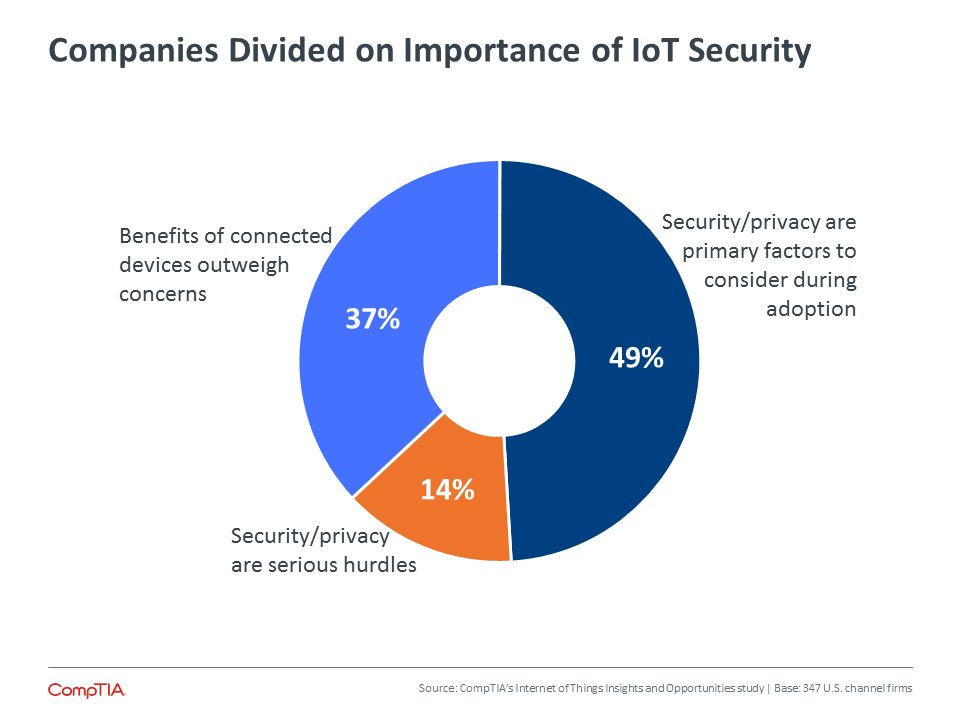
One topic in particular has seen renewed interest as it has transformed for this new era. Security was once the primary hurdle for cloud computing, but most companies have cleared that hurdle and are now examining what modern security should look like as they pursue a cloud strategy. IoT introduces a new wave of security and privacy issues, and channel companies are somewhat split in their assessment of how this will affect adoption.
In general, there is a belief that security concerns will not be a major hurdle for IoT implementation. Just 14% take this viewpoint, with that segment dominated by small and medium-sized companies. On the other end of the spectrum, there are firms that believe that their client will focus heavily on the benefits and figure security out later. Large channel firms dominate here, with 46% of large firms holding this viewpoint compared to 33% of medium-sized firms and 31% of small firms. The halfway point is the most popular outlook, where channel firms believe that companies will aggressively pursue IoT projects but still give serious consideration to the new approaches needed for security and privacy.
Segmenting responses by job function is more telling than segmentation by company size. Nearly half (49%) of those respondents in an executive position feel that the benefits of connected devices outweigh security concerns, compared to 34% of respondents in an IT function and 26% of respondents in a line of business function. Instead, those lower-level employees tend towards the balanced viewpoint—54% of IT workers and 57% of business workers feel that security should be a strong consideration during adoption. Both IT and business functions have come to appreciate the potential pitfalls of poor security, but this message still needs to be baked in to overall technology discussions at the executive level.
Unsurprisingly, hackers are the main security concern for IoT. Sixty-five percent of the sample views hackers as the greatest threat for IoT security/privacy. The growing organization and sophistication of hackers along with the growing attack surface of the IoT ecosystem give this long-standing threat a new life in the new era.
Beyond hackers, the new pieces of the ecosystem pose significant threats as well. Vulnerabilities left open by device manufacturers (52%) and unencrypted data traveling across networks (51%) are danger areas that solution providers should focus on as new vendors become part of a technology portfolio and data transmission becomes a critical part of business operations.
Although the surreptitious collection of data makes for good headlines, most channel firms do not see this as a major threat. Only 44% are concerned about the collection of data by device manufacturers, and 32% are concerned about the government gaining access to devices and data. These entities also have their reputations to think about—in an age of hackers and leakers, transparency is a key motivation.
That transparency trickles down to the way channel firms engage with clients. As IT systems grow more complex and the number of players involved in the overall architecture goes up, the potential liability for any single player also increases. One third of channel firms say they will refuse business without agreement to strict conditions in a contract that define liability or describe client responsibilities. Another 42% say that they strongly advise their clients on best practices rather than leaving tangential technology decisions up to the customer.
A new world order demands new behavior. As the implications of security and privacy become prodigious, channel firms must educate their clients on the best approach, then carefully define expectations and obligations. Security will not stop (or even slow) IoT adoption, but the companies that thrive in the future will be those that adapt quickly to the new paradigm.
Section 3:
Customer / End-user Perspectives
Key Points
- By many accounts, the Internet of Things (IoT) trend has moved from ambiguous buzzword to market-ready products and services having real-world impacts across the U.S. economy. CompTIA research reveals 8 in 10 organizations have a more positive view of IoT today compared to a year ago. This reflects greater levels of attention from the C-suite and a better understanding of how the many different elements of the IoT ecosystem are starting to come together.
- Given the many flavors of IoT – from the simple deployment of a sensor and app to the very complex system of systems, there is a diverse set of factors affecting adoption. Among the more than half of firms that claim to have some type of formal or pilot IoT project underway, key motivations include cost savings from operational efficiencies, time savings and decision-making agility from new streams of data, and better customer experiences. Conversely, concerns over cost, complexity, security, and workforce requirements will need to be addressed for the market to reach its potential.
- Analysis of how various industry sectors are approaching IoT indicates a number of similarities, as well as a few differences. Across the sectors examined in this study – manufacturing, retail, hospitality, healthcare, government, and AMTUC (agriculture, mining, transportation, utilities, and construction), awareness rates of IoT were nearly uniform. Additionally, all the sectors, with the exception of the government sector, rated IoT as the emerging technology most likely to be having an immediate impact on their sector. Interest in cost savings, new streams of data, and productivity gains ranked high across most sectors. The retail sector expressed the most optimism in leveraging IoT capabilities to generate new sources of revenue.
Setting the Stage
As technology continues its decade-long transition from back office supporting function to all-encompassing strategic imperative, businesses face an increasingly complex set of thorny questions. Executives across the C-suite must not only keep pace with the whirlwind of innovation, but also anticipate potentially far-reaching implications for staff, customers, partners, and even the broader industry sector itself.
CompTIA’s Building Digital Organizations study confirms organizations of all types have made progress in transforming their operations through cloud computing, mobility, social, big data, business process automation, and related. While this progress is a step in the right direction, most firms still have much work to do. And, with another wave of emerging technologies looming, already high stakes will get even higher.
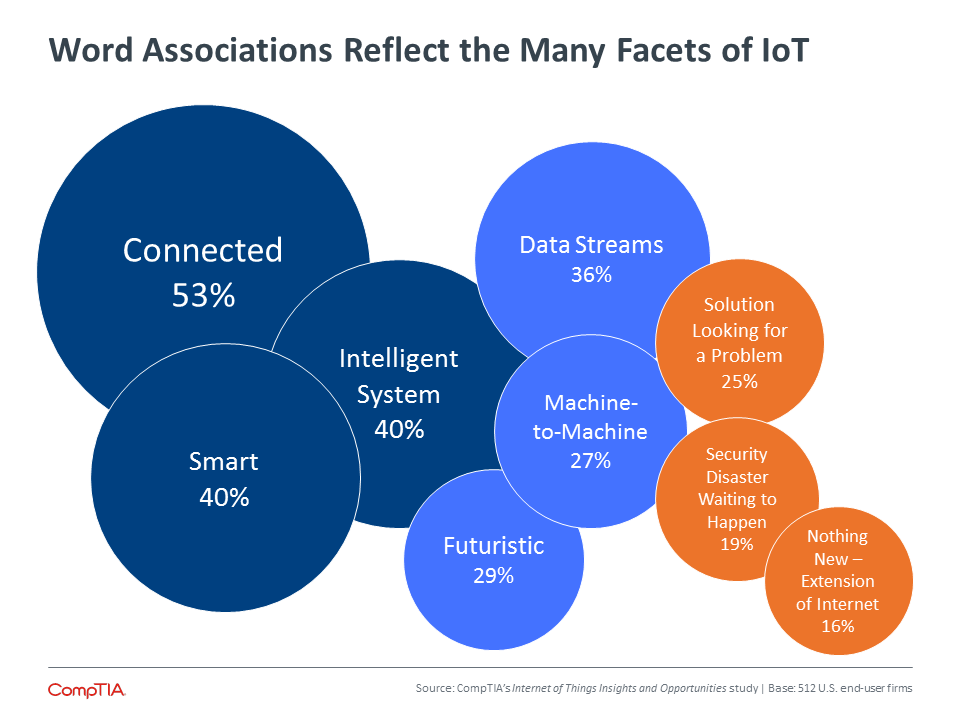
There has been much discussion among industry pundits as to how to characterize the state of technology and the transitions underway. Labels such as the Internet of Things era, the cognitive computing era, or even the immersive computing era, just to name a few, get bandied about. CompTIA’s Internet of Things Insights and Opportunities study attempts to provide a few clues as to what the future may hold. The research reveals businesses (aka customers or end-users) are most likely to associate the concept of IoT with ever-greater levels of connectivity; more intelligence built into devices, objects, and systems; and a strong data and applied learning orientation. While these views are specific to IoT, they could easily serve as a proxy for many of the emerging technologies evaluated on the following page. Moreover, these end-user views sync-up well with the macro trends of more powerful and pervasive computing and storage, the further blurring of the physical and the virtual, and the harnessing of big data for real-world functional activities. These components underpin numerous emerging technologies, many of which, have moved from concept to commercial or near commercial-ready viability in short order. Generally high awareness rates of 3-D printing, drones, and IoT is further testament to the market readiness of segments of emerging technologies. Certainly there are limitations to self-reported awareness rates as they are not intended to assess deep technical knowledge, but they do provide a sense of the degree to which the terminology has penetrated the business world.


A few other observations from the emerging technologies awareness rates: end-users report slightly higher rates of awareness of virtual reality (VR) than self-driving / autonomous vehicles. While VR has a number of tech heavyweights driving the market – Facebook with Oculus, Google, Samsung, and Microsoft, the category has arguably received less coverage and attention than self-driving vehicles. When Google’s self-driving car got into a minor fender-bender with a bus in Mountain View, CA earlier this year, the story was covered in just about every major news outlet. Additionally, it may be a function of the perception among many organizations of the near-term relevance of VR and AR relative to self-driving vehicles.
The buzzword du jour appears to be anything related to ‘bots,’ yet this rated on the low side in the CompTIA survey. See CompTIA’s research brief Tech on the Horizon: From VR to Bots for more details on bots and other trends.
Analysis of awareness rates by industry sector reveals only minor differences. Even sectors that are often stereotypically viewed as “old line,” such as agriculture, mining, transportation, utilities, and construction (AMTUC) report familiarity of emerging technologies at about the same rates as other industry sectors. Differences do start to emerge, however, in perceptions of when these technologies will begin to have an impact. With the exception of the government sector, each of the sectors evaluated ranked IoT highest in terms of a technology already having an impact. While there is likely a degree of subjectivity in what can be considered ‘having an impact,’ these results nonetheless confirm a viable market forming around certain technologies.
The data indicates end-users are being influenced by the usual mix of information sources. Beyond the news, 43% have had internal discussions with staff, which may have entailed informal discussions to formal project management meetings for IoT pilots underway. Despite perceptions (or misperceptions) of millennials’ news consumption patterns, the 20-somethings in this study had nearly identical patterns of IoT information consumption as older age segments (see Appendix).
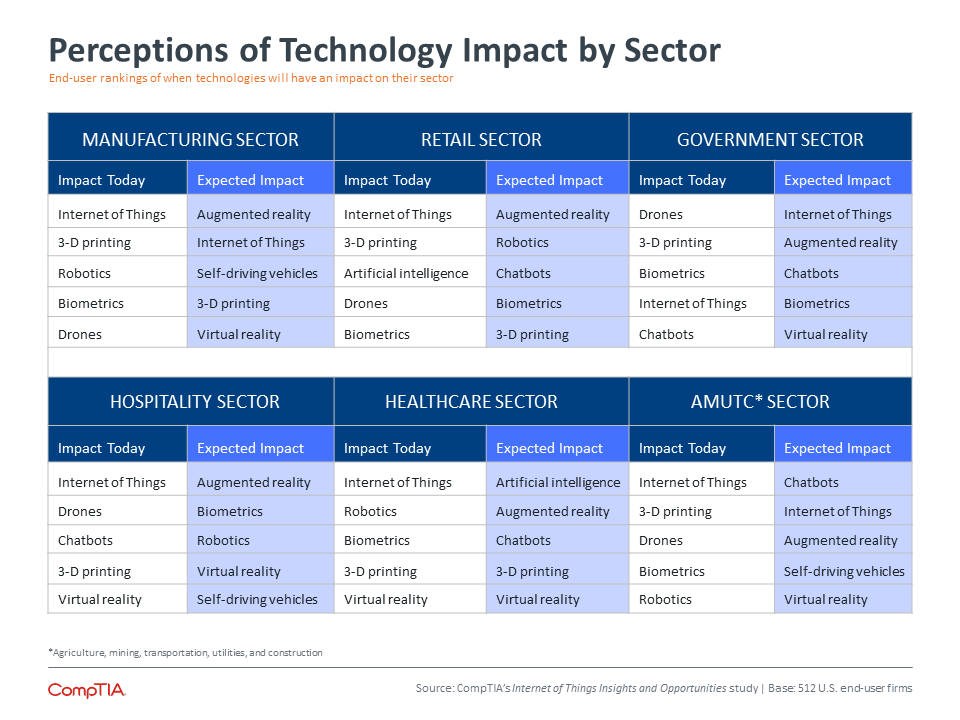
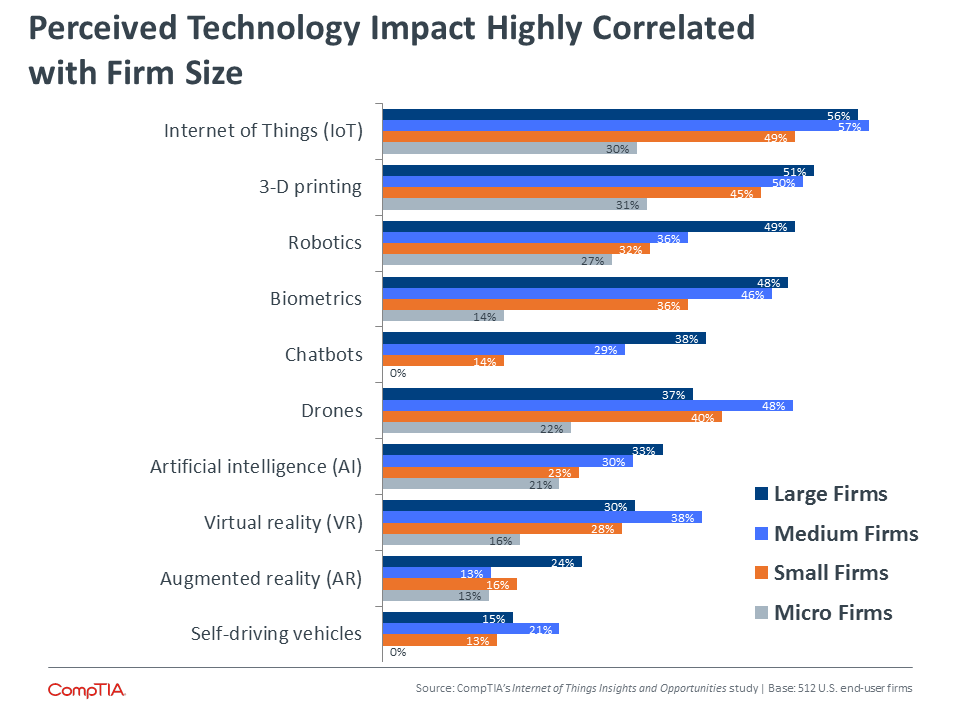
Making the Case for IoT
As described in CompTIA’s IoT ecosystem framework in Sections 1 and 2, IoT is more than a product or service, or even a collection of a few products or services. Many elements must come together for IoT to deliver expected benefits. Strong majorities of business and IT executives view IoT more positively today compared to a year ago, suggesting these elements are starting to fall into place. Furthermore, with 6 in 10 organizations claiming to have some type of IoT initiative underway, this certainly seems to be the case.
As usual, with self-reported adoption rates, caveats do apply. Despite the best efforts of the researchers conducting this study, there is always the likelihood of segments of respondents mischaracterizing, or even misunderstanding, the technology initiatives their company has underway. Additionally, among those with a legitimate IoT initiative in the works, it’s worth keeping in mind, it could be a fairly modest endeavor, such as a few sensors placed in the office plants to signal the need for watering. Yes, this is technically an IoT initiative, but probably not what major tech vendors have in mind when they are evaluating customer demand. However, even if the adoption rates are somewhat elevated or involve a relatively low degree of difficulty, it still represents a notable move beyond the very earliest of adopters of IoT.
As expected, larger organizations are slightly more likely to report having a formal IoT initiative underway. Although the data is inconclusive due to the smallish sample size, an evaluation of industry sectors suggests the retail, hospitality, and manufacturing sectors are slightly more likely to have an IoT initiative underway compared to the healthcare, government, or AMTUC sectors.
A sign IoT may be viewed as a slightly different type of investment than routine technology expenditures is the degree to which IoT initiatives are being funded with new budget allocations. Because new budget allocations typically require the buy-in from CEOs and CFOs, it implies IoT has the attention of senior leadership at many organizations.

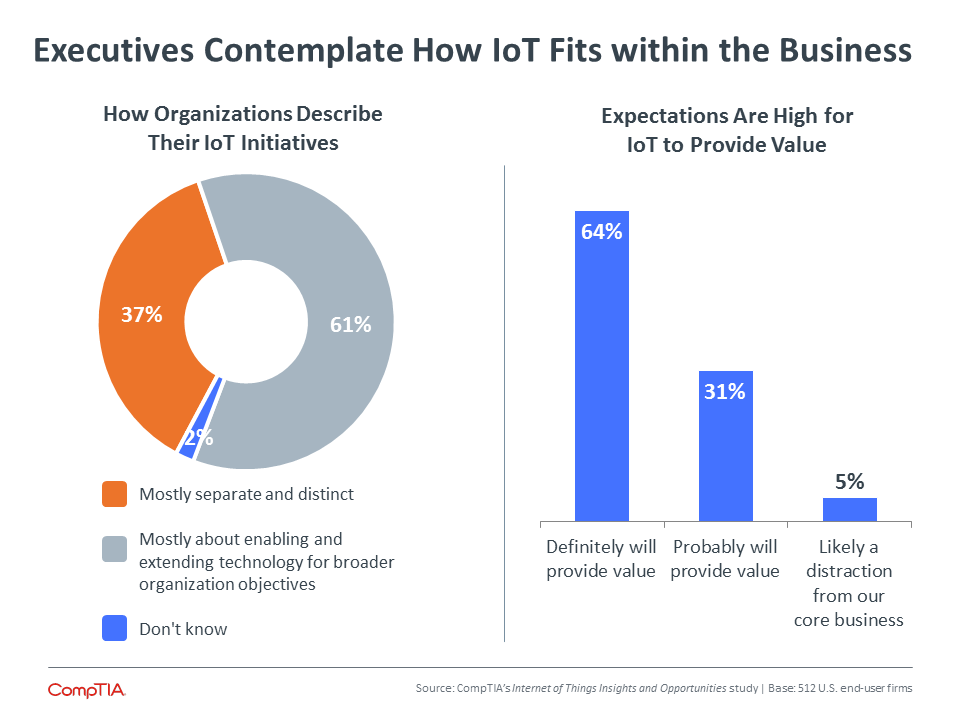
Existing or planned spending on IoT unquestionably bodes well for the market, but it does mean the “clock is now running” with return on investment expectations. These expectations can be divided into perceptions of IoT value that improve and extend existing business processes, systems, or related functions, and IoT benefits that stem from something new. This could be a completely new stream of data, a new customer experience, or an entirely new product category derived from layering service elements on top of legacy infrastructure, for example.
When asked about the perceived benefits of IoT, the top five ranked items are roughly evenly split between what could be characterized as ‘improving/extending the existing’ and ‘leveraging the new.’ Obviously, there will be areas of overlap where IoT may provide values on both axes. As a starting point for mapping IoT benefits to marketing or sales plans, this type of matrix can help frame the discussion.
Top 5 Perceived Benefits of IoT
Cost savings from operational efficiencies
New / better streams of data to improve decision-making
Staff productivity gains
Better visibility / monitoring of assets throughout the organization
New / better customer experiences
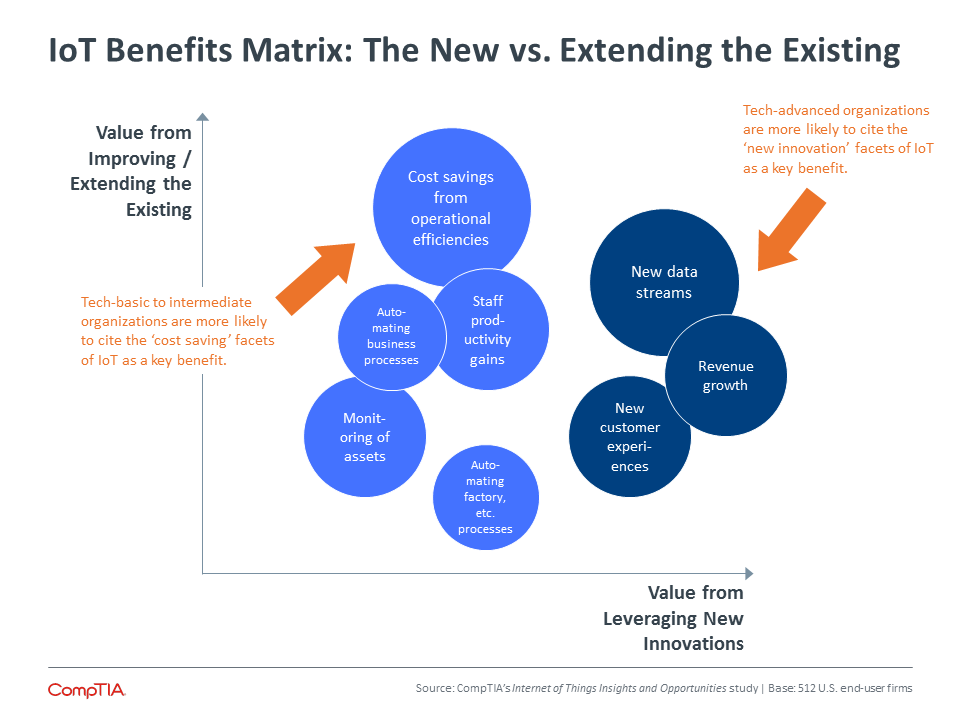
Falling just outside of the top 5 benefits ranking, 1 in 3 respondents cite an expectation of new revenue growth from IoT investments. Closely tied to cost savings from operational efficiencies, automating business processes or industrial processes also made the list of expected benefits from IoT.
Sector analysis reveals many similarities and a few differences in the perceived benefits of IoT. Cost savings from operational efficiencies or new data streams for better decision-making rank first or second across the board. The interest in data is especially strong in the government sector. This makes sense given the many layers, agencies, jurisdictions, and constituencies government workers must navigate. Even small improvements in empowering government workers with the right data at the right time can pay dividends. See CompTIA’s companion piece on Smart Cities for more analysis of IoT in the government space.
Given the heavy focus on maximizing revenue for most business executives, it’s somewhat surprising this aspect of IoT ranks on the low end of the list. It’s probably safe to say the interest is there, although perhaps respondents don’t see the path to revenue with IoT as readily as they see the potential for cost savings.
Among all sectors, retailers express the most optimism for generating revenue from new IoT-enabled products or services. There is already a fairly robust base of IoT technologies developed for the retail sectors. Examples may include the use of digital signage to provide more engaging in-store experiences; the use of beacon technology to offer location-based, real-time discounts; the use of facial-recognition technology and big data to understand customer traffic patterns and reactions to displays; or even the use of drones for delivery. Major big-box retailers, not to mention the leading online retailers, have been experimenting with these types of technologies for years now. With razor thin margins, expensive overhead, and savvy shoppers, retailers tend to seek out new revenue opportunities with a vengeance.
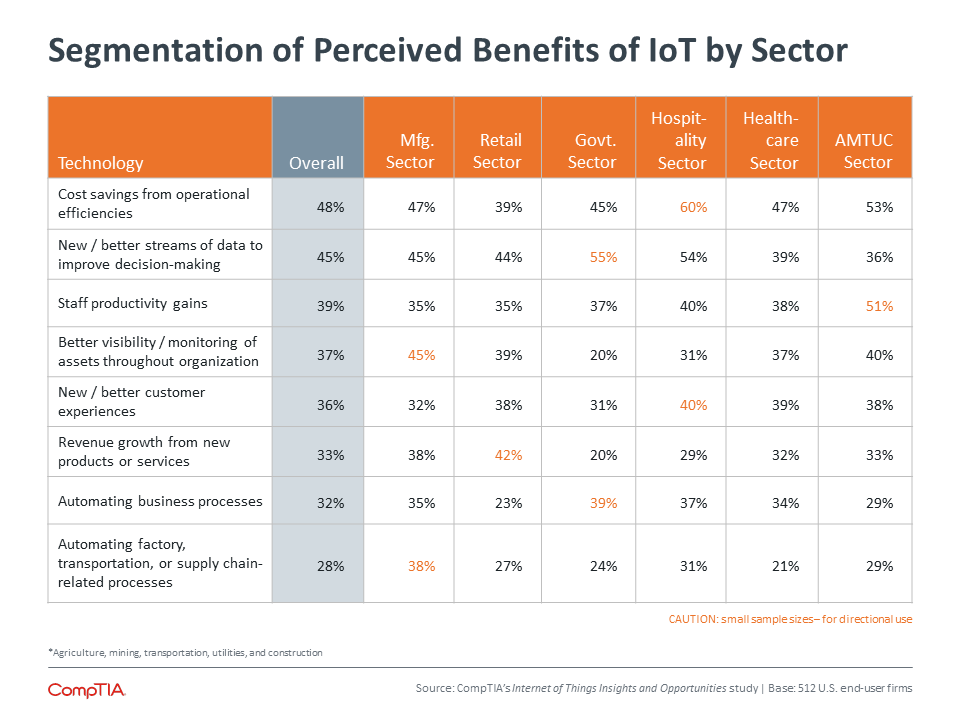
Barriers to Adoption and Areas of Concerns
Like most technology progressions, IoT will not be a smooth hockey stick curve, but rather a more step-like pattern. Inevitably there will be periods where forward momentum stalls and expectations are recalibrated. This may stem from technical hurdles to regulatory hurdles, or even general economic weakness leading to a pullback in spending.
Ranking of Factors Most Likely to Inhibit IoT Adoption:
Upfront cost
Lack of skilled workers with necessary IoT expertise
Ongoing fees / maintenance costs
New cybersecurity risks
Interoperability with existing systems / devices
Complexity
Difficulty in quantifying the return on investment (ROI)
A number of these factors – cost, interoperability, complexity, and security, are routinely covered in news stories and tech blogs covering IoT. Receiving less attention, but equally important, are issues such as the need for a skilled IoT workforce and the resources required for ongoing maintenance. Executives in the study astutely cited these factors as significant potential challenges. The workforce issues are especially critical. CompTIA’s extensive body of workforce research shows employer demand for many IT skills frequently exceeding the supply of workers. IoT and related emerging technologies will likely exacerbate the problem – at least in the near-term, as industry sectors across the economy pursue tech talent. Training and development programs will help in addressing skills gaps among existing workers or retraining workers in obsolete fields, but it takes time for these programs to ramp up.
The issue of cybersecurity also warrants special attention. As detailed in countless studies, no organization is 100% protected from security assaults and/or breakdowns. With IoT pushing ever-greater levels of interconnectivity, new risks and vulnerabilities will be exposed. When asked about security and IoT, 57% of respondents believe their organization is very well equipped or mostly well equipped to manage the security component of IoT. Given the number of security unknowns with IoT, especially in areas that may be beyond the control of the operator, this confidence may be misplaced.

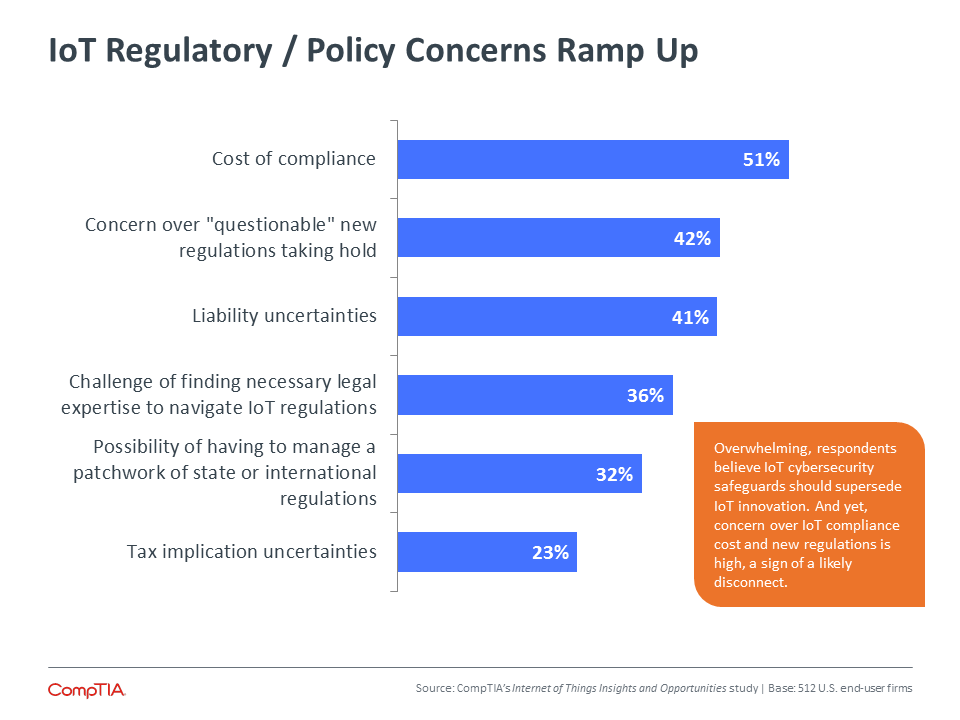
Regulatory and compliance concerns can generally be considered an extension of the top level adoption barriers and concerns, although there are a few distinctions. From an end-user perspective, cost and uncertainty rank as the most pressing concerns. Businesses can account for known costs and plan accordingly. Unknown costs and other market uncertainties can be a major stumbling block, causing risk aversive CFOs and CEOs to postpone action indefinitely. Interestingly, businesses also rated the concern over being able to find the necessary legal expertise to navigate the IoT regulatory landscape as a potential issue that could slow IoT developments.
Key IoT Regulatory and Policy Areas of Deliberation:
Security
Data privacy
Spectrum and standards
Commerce rules and regulations
Public-private partnerships
A cursory review of the IoT uses below reveals a market moving much faster than the speed with which regulatory bodies can make the rules. Most industry sectors are thankful government hasn’t rushed into IoT rulemaking. At the same, it’s not uncommon for industry executives to bemoan the uncertainty. Tough for government agencies to win in this situation. It should be noted, government branches, such as the U.S. Senate, the House of Representatives, FTC, FCC, DoT, FAA, the EU Commission, and others, have held hearings or deliberations addressing some aspect of IoT.
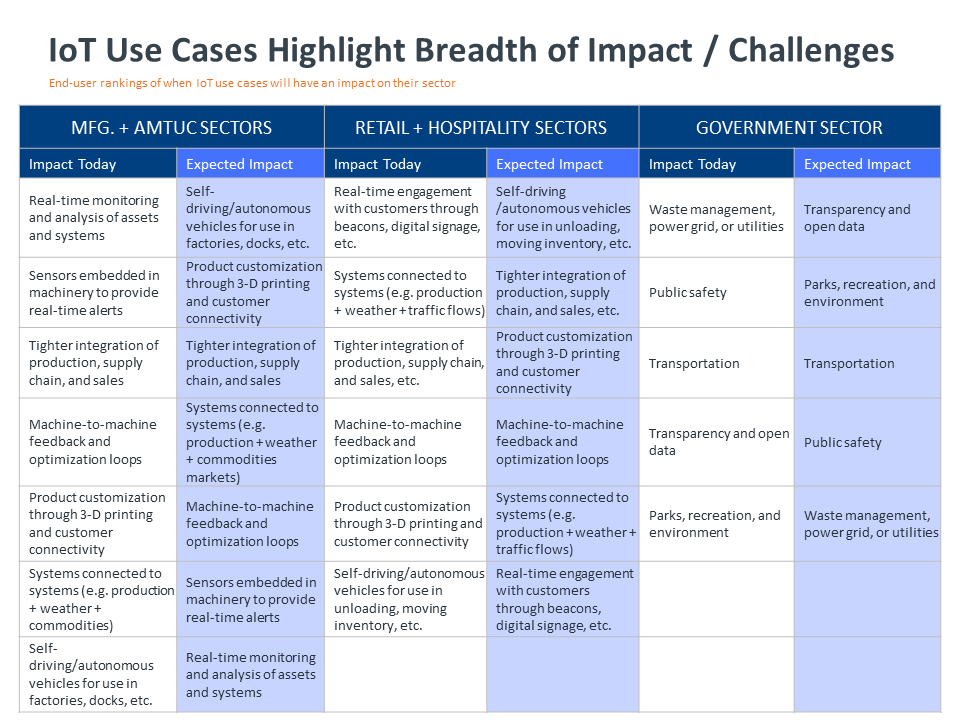
A Few Takeaways for Technology Providers and Channel Partners
The Emerging Tech Market Is on the Move
VCs continue to place significant bets on a wide range of emerging technologies. M&A activity remains brisk, with tech bellwethers snapping up hot startups. Non-traditional players in historically non-tech savvy industries are making waves with their push to re-engineer everything from farming to freeways.
For the opportunistic, this flurry of activity may be viewed with open arms. For the segments of the channel still playing catch-up with cloud, big data, or even mobility, this may be viewed as another Sisyphean moment. Just when you think you are getting close to conquering a challenge, a new “market disruption boulder” comes tumbling down the hill and it’s time to start all over again.
For channel partners in the latter camp, unfortunately, there is no simple formula for how to proceed, but there are a few tried-and-true practices worth remembering. BHAGs (big hairy audacious goals) are best tackled by breaking the problem down into smaller, more manageable pieces. There are many interim steps channel partners can take before making any major commitments to new product lines. One of these steps entails taking advantage of available information, guidance, and support from vendors, distributors, mentors, and industry trade associations. It is often available for the taking. Another step entails carving out dedicated time to focus on emerging areas. Following the model used most famously by Google, considering allowing certain staff to allocate a portion of their time to “tinkering” or exploring new technologies, business models, or partnerships. Obviously, there is a lot more to it than the simple steps referenced above. You have to start somewhere, though.
Be a Resource: Customers Will Rely on You…or Someone Else
With customer awareness rates reasonably high across many emerging technologies it’s an indication there has already been a degree of early stage information gathering. Additionally, customers believe technologies such as IoT, 3-D printing, and biometrics, are already starting to have an impact on their industry sector. In some cases, that impact is being experienced firsthand as 6 in 10 customers claim to have some type of IoT project or pilot underway. Taken together, it means segments of customers are actively seeking information to begin an initiative with an emerging technology, or take an existing initiative to the next level.
If channel partners were not already motived to serve as a resource and trusted advisor, consider another point from the research. When asked about the factors that make businesses tech-savvy and/or tech-forward, the top ranked item among end-users was the ability to identify and quickly implement innovation. Channel partners able to fill this need will be well positioned over the long-term.
Make the Connection
Related to the point above, another factor rated by end-users as important to being a tech-savvy/tech-forward business is the reliability of technology – everything just works. This aligns well to the strengths of many channel partners. However, it may not always be obvious to customers. Consider the example of a typical IoT solution. Yes, there will be sensors, data, and feedback loops. But, there will also be a need for network management, reliable bandwidth, BC/DR, break/fix, and security. There is nothing wrong with indulging customers’ interest in the cool and fun side of technology, just be sure to have well thought-out messaging for how all the pieces fit together and why it’s critical to ensuring ‘everything just works.’
Building on this point, customers cite complexity and interoperability as two likely challenges that will affect their ability to implement IoT solutions. With segments of businesses seeing these issues as expected challenges, the work of convincing customers of a problem in need of solving is already partially done. Of course, it will require a depth of expertise and a willingness to “learn on the go” to manage IoT complexity and interoperability issues, but for IT solution providers willing to take the plunge, a base of customers should be receptive to their overtures.
ROI Discussions Should Start with Functionality and Value…And Then the Technology
Turning to the research again, two points to consider. For organizations with an IoT initiative underway, the largest percentage report funding it with a new budget allocation. Secondly, among organizations that have not yet embarked on an IoT initiative yet, but expect to do so, a net 3 in 4 respondents expect it will be very challenging or somewhat challenging to assess the value of IoT to their business. Further corroborating this concern, customers rate cost and ROI as two key factors that could slow adoption of IoT.
Demonstrating ROI in emerging product categories when there isn’t much of a track record is challenging, but not impossible. This starts with knowing the audience. According to the research, the CIO, CTO, or other IT staff are leading the way for most IoT initiatives (71%). They are rarely the sole decision-maker though. Forty-six percent of businesses report the involvement of the CEO or president, and 31% report the involvement of business unit leads such as CMOs or COOs. While technical details, and the corresponding value of what is delivered for the money, will undoubtedly be part of the sales engagement, the discussion shouldn’t start, nor stop there. The traditional sales 101 approach to these situations was to ask a battery of questions to feel out the customer and then respond accordingly. That approach generally does not cut it anymore. Given the abundance of information available and the changing dynamic between buyer and seller, customers increasingly expect their technology provider to anticipate pain points, business relevance, and where solutions fit within broader technology roadmaps. Proactively thinking through issues help lay the groundwork for tackling ROI discussions.
Appendix
About this Research
CompTIA’s Internet of Things Insights and Opportunities (IoT) study examines the state of IoT from the perspective of technology, the channel, and customers (end-users).
The study consists of three sections, which can be viewed independently or together as chapters of a comprehensive report.
Section 1: Market Overview
Section 2: Channel Dynamics
Section 3: Customer / End-user Perspectives
The data for this quantitative study was collected in two parts.
Part 1: online survey conducted during May/June 2016. A total of 350 IT channel professionals in the U.S. participated in the survey, yielding an overall margin of sampling error at 95% confidence of +/- 5.3 percentage points. Sampling error is larger for subgroups of the data.
Part 2: online survey conducted during May/June 2016. A total of 512 business and IT executives (aka customers or end-users) participated in the survey, yielding an overall margin of sampling error at 95% confidence of +/- 4.4 percentage points. Sampling error is larger for subgroups of the data. The study targeted the following industry sectors: manufacturing, retail, hospitality, healthcare, government and AMTUC (agriculture, mining, transportation, utilities, and construction).
As with any survey, sampling error is only one source of possible error. While non-sampling error cannot be accurately calculated, precautionary steps were taken in all phases of the survey design, collection and processing of the data to minimize its influence.
CompTIA is responsible for all content and analysis. Any questions regarding the study should be directed to CompTIA Research and Market Intelligence staff at [email protected].
CompTIA is a member of the Market Research Association (MRA) and adheres to the MRA’s Code of Market Research Ethics and Standards.
Read more about Technology Solutions, Industry Trends.

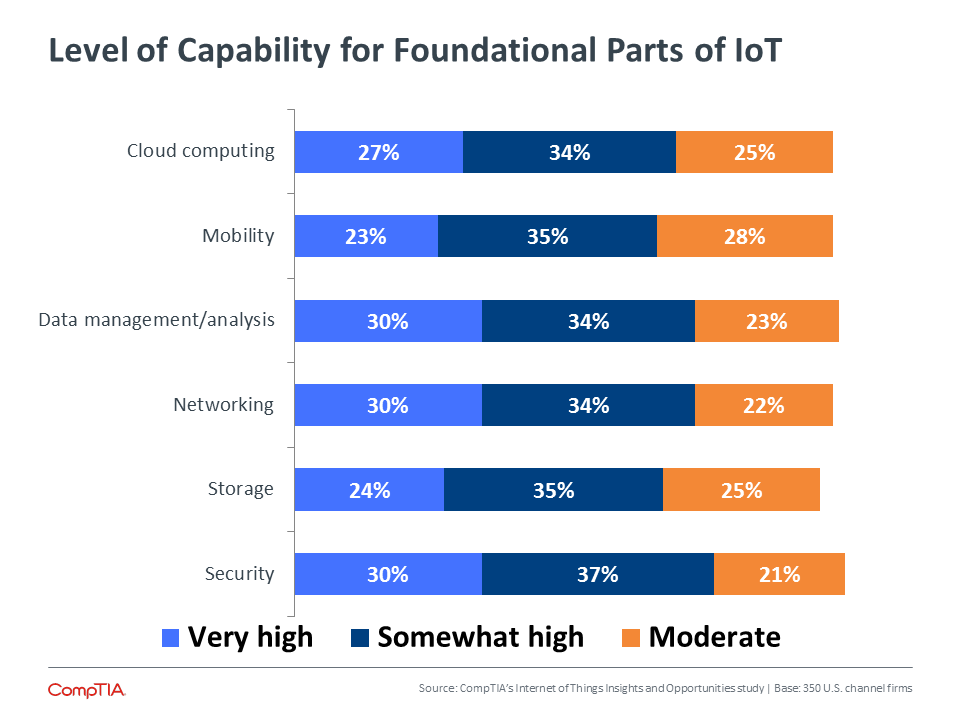

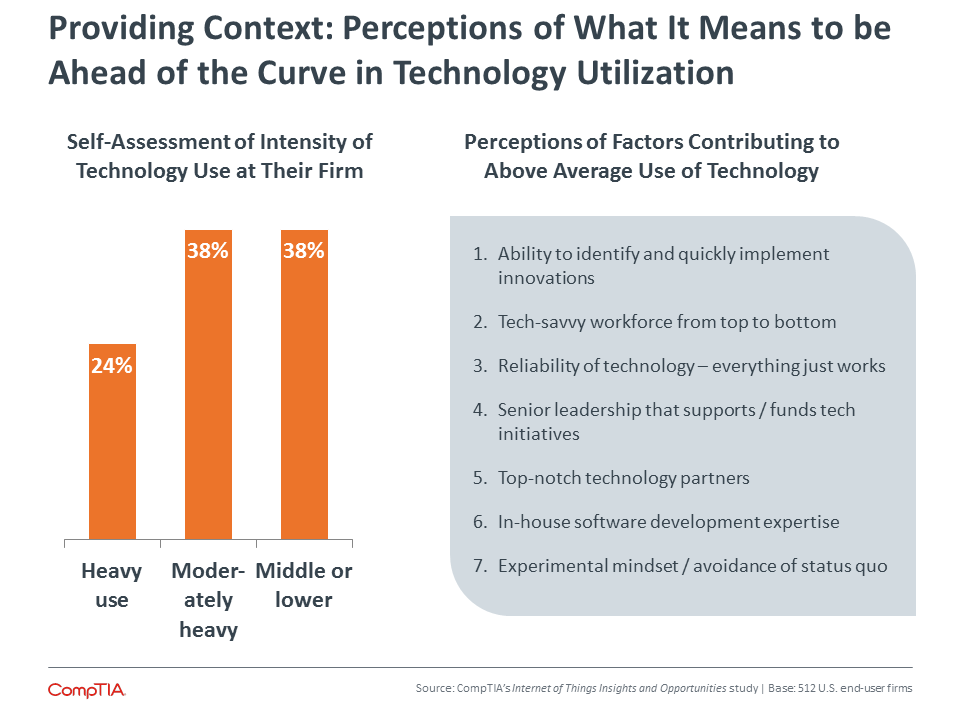
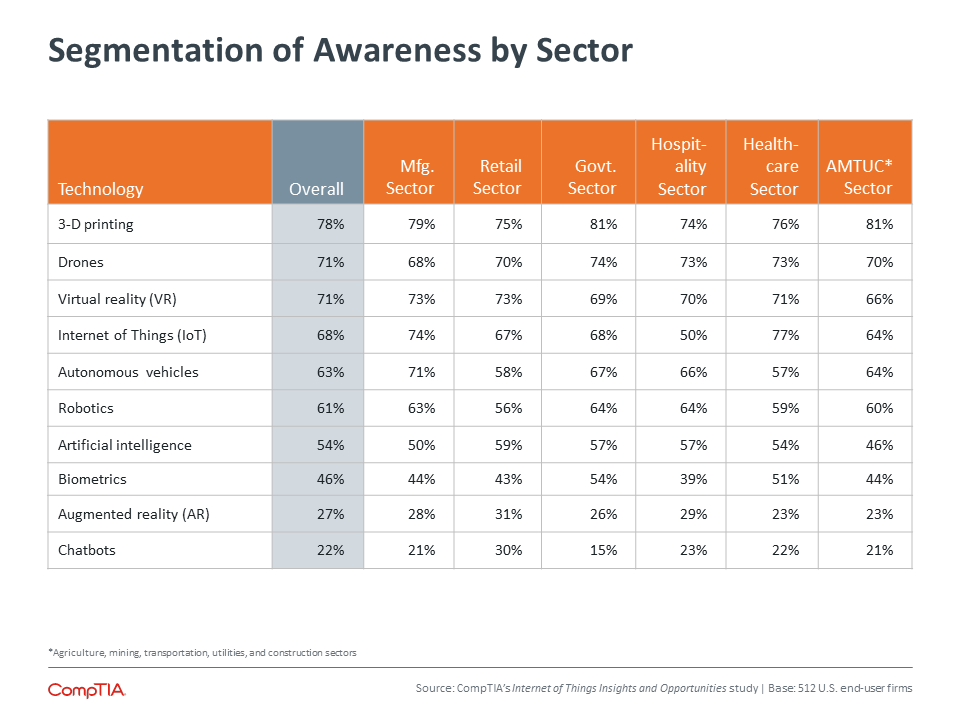
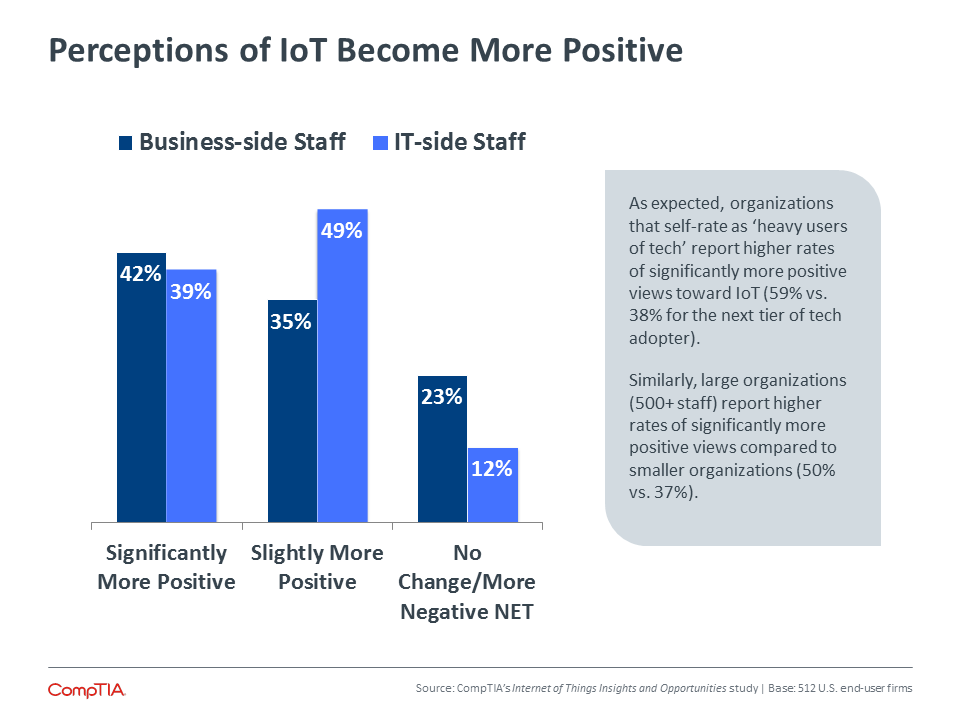
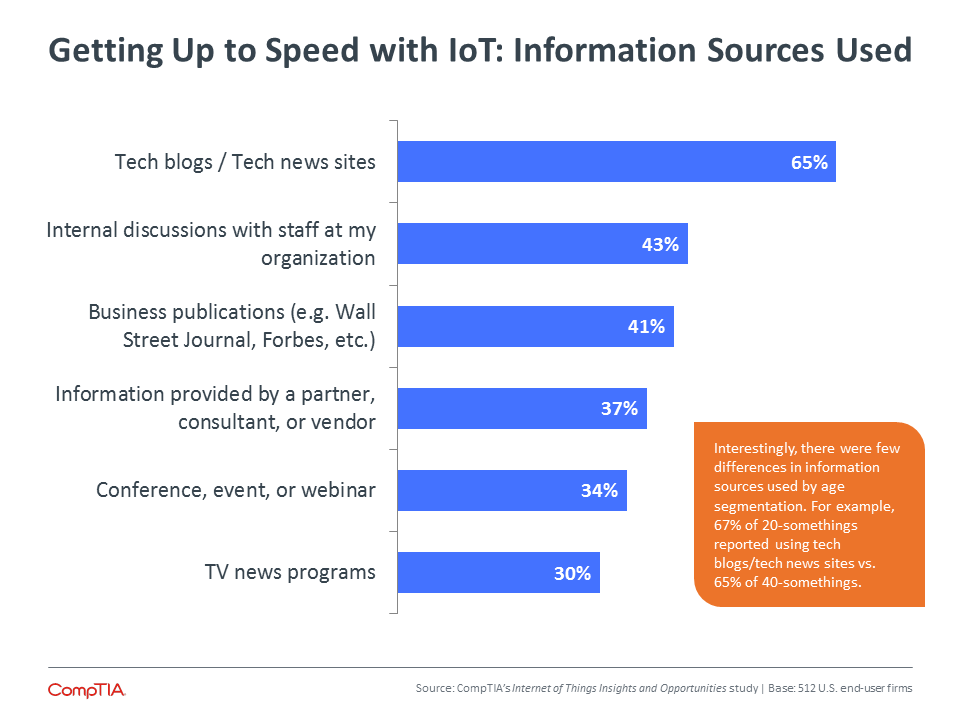
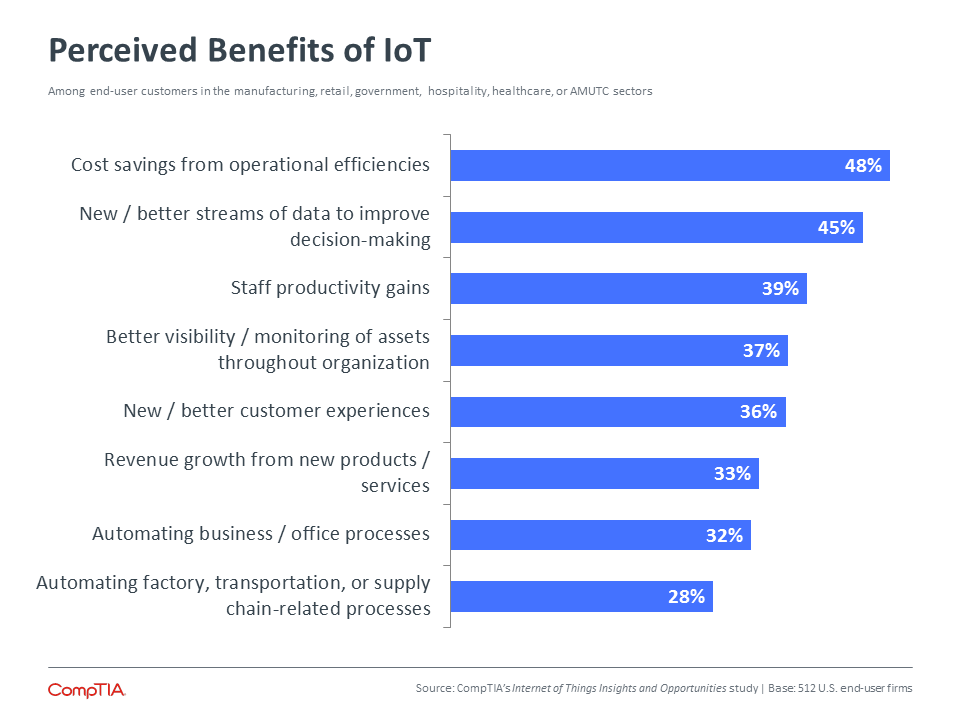
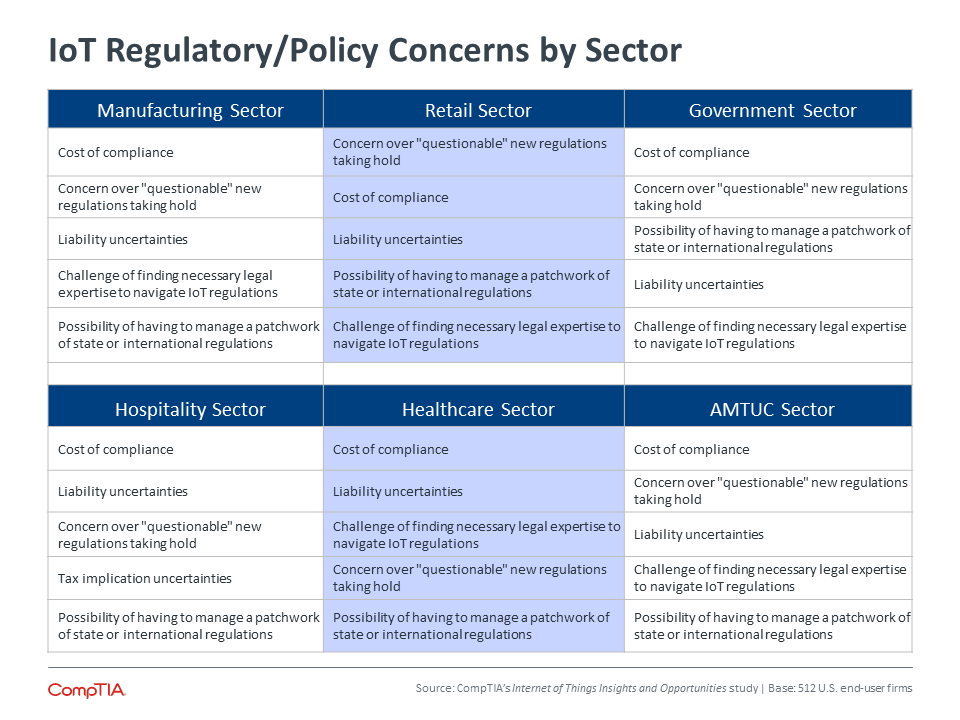
 Download Full PDF
Download Full PDF